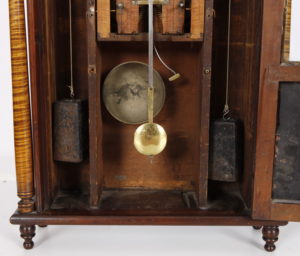Lehigh Valley PA Pillar & Scroll Clock
There was a community of Pennsylvania German craftsmen at work in the Allentown area during the first half of the 19th Century building shelf clocks by hand. This was in stark contrast to mass produced clocks made in the Connecticut factories by makers such as Eli Terry & Seth Thomas. Pennsylvania shelf clocks were made in small numbers and with multiple configurations and variations. If you have never examined one in person you immediately notice the bold, robust construction and weight of the clock as compared to a Connecticut example. The primary woods were typically local native hardwoods such as Maple, Cherry and Walnut with Tulip Poplar and Pine secondary woods. This is a known and documented clock as it was in the collection of Virginia and Edward LaFond and discussed in the book “Pennsylvania Shelf and Bracket Clocks 1750 – 1850 by Edward F. LaFond and J. Carter Harris on page 17. The catalog documents and exhibit that took place in 1983 and the photos in the book published in 2008 were in fact taken during the exhibit. After the exhibit the clock was sold and the owner decided to have the case refinished only to discover that underneath that red wash/stain/grunge were beautiful Tiger Maple facings. There is still evidence of that red stain/wash/grunge on the edges of the door frame, top and bottom of pillars, and edges of the crest as well. When we acquired the clock I shared the information with Ed and his son Will. Will and Virginia took a ride out to visit and have a look at the clock and Will took it back home with him and did a complete overhaul.
The Pennsylvania Pillar & Scroll has bold scroll molding, heavy turned columns, turned rosettes, and turned feet along with a thick raised panel backboard that slides into the back of the case. The sides are mortised into the bottom. The cases were also designed for several types of movements including wood plate as well as brass.
The dial is painted iron plate as is the lower tablet. After 175 years of service the dials and tablets have survived the test of time quite favorably as compared to their Connecticut counterparts with wooden dials (often found with stretch marks and paint loss) and painted glass tablets (often flaked and/or cracked). The works at first glance have the appearance of a German Black Forest “Wag-On-The-Wall” clock, however the research by Ed LaFond and his correspondence with all of the major European Clock Museums has failed to produce a single shelf clock with these movements in Austria, Switzerland, or Germany. One must conclude that these movements while inspired and derived from the Black Forest Wag-On-The-Wall were in fact made in Lehigh Valley Pennsylvania and not imported from Europe.
The movement is a 30-hour wood plate with cast brass gears, lantern pinions, and steel arbors housed in a Beech wood frame with side rails that are dovetailed to the top and bottom boards. The count wheel in this movement is on the back of the plate which is typical for a “Wag-On-The-Wall” but unusual in a shelf clock. The movement has been professionally serviced and the clock runs and strikes fine. The weights, pendulum and winding crank are all original. On the inside of the door frame is a script signature that appears to be the name of the maker. The clock is 30 1/2 X 17 1/2 X 5 1/2 inches with a 12 1/2 X 11 1/2 inch painted iron dial. An extremely rare and desirable clock !
SOLD













